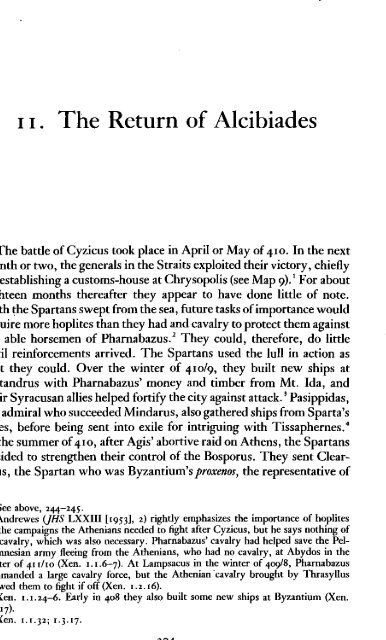The Fall of the Athenian Empire-(A New History of the Peloponnesian War) Donald Kagan - (1987)
MACEDONIA is GREECE and will always be GREECE- (if they are desperate to steal a name, Monkeydonkeys suits them just fine) ΚΑΤΩ Η ΣΥΓΚΥΒΕΡΝΗΣΗ ΤΩΝ ΠΡΟΔΟΤΩΝ!!! Strabo – “Geography” “There remain of Europe, first, Macedonia and the parts of Thrace that are contiguous to it and extend as far as Byzantium; secondly, Greece; and thirdly, the islands that are close by. Macedonia, of course, is a part of Greece, yet now, since I am following the nature and shape of the places geographically, I have decided to classify it apart from the rest of Greece and to join it with that part of Thrace which borders on it and extends as far as the mouth of the Euxine and the Propontis. Then, a little further on, Strabo mentions Cypsela and the Hebrus River, and also describes a sort of parallelogram in which the whole of Macedonia lies.” (Strab. 7.fragments.9) ΚΚΕ, ΚΝΕ, ΟΝΝΕΔ, ΑΓΟΡΑ,ΕΚΚΛΗΣΙΑ,ΝΕΑ,ΦΩΝΗ,ΦΕΚ,ΝΟΜΟΣ,LIFO,MACEDONIA, ALEXANDER, GREECE,IKEA
MACEDONIA is GREECE and will always be GREECE- (if they are desperate to steal a name, Monkeydonkeys suits them just fine)
ΚΑΤΩ Η ΣΥΓΚΥΒΕΡΝΗΣΗ ΤΩΝ ΠΡΟΔΟΤΩΝ!!!
Strabo – “Geography”
“There remain of Europe, first, Macedonia and the parts of Thrace that are contiguous to it and extend as far as Byzantium; secondly, Greece; and thirdly, the islands that are close by. Macedonia, of course, is a part of Greece, yet now, since I am following the nature and shape of the places geographically, I have decided to classify it apart from the rest of Greece and to join it with that part of Thrace which borders on it and extends as far as the mouth of the Euxine and the Propontis. Then, a little further on, Strabo mentions Cypsela and the Hebrus River, and also describes a sort of parallelogram in which the whole of Macedonia lies.”
(Strab. 7.fragments.9)
ΚΚΕ, ΚΝΕ, ΟΝΝΕΔ, ΑΓΟΡΑ,ΕΚΚΛΗΣΙΑ,ΝΕΑ,ΦΩΝΗ,ΦΕΚ,ΝΟΜΟΣ,LIFO,MACEDONIA, ALEXANDER, GREECE,IKEA
You also want an ePaper? Increase the reach of your titles
YUMPU automatically turns print PDFs into web optimized ePapers that Google loves.
276 -THE FALL OF THE ATHENIAN EMPIRE<br />
winter <strong>of</strong> 409/8, <strong>the</strong> two contingents worked toge<strong>the</strong>r to fortify Lampsacus<br />
and turn it into a secure center for operations.<br />
When all was ready, <strong>the</strong> A<strong>the</strong>nians attacked Abydos. Success would<br />
deprive <strong>the</strong> Spartans <strong>of</strong> <strong>the</strong>ir only base on <strong>the</strong> Hellespont and give<br />
A<strong>the</strong>ns full control <strong>of</strong> that waterway. <strong>The</strong> battle seems to have unfolded<br />
as follows: Thrasyllus made <strong>the</strong> first assault, having been sent<br />
ahead by sea with thirty ships. Phamabazus discovered what was<br />
happening and came to <strong>the</strong> rescue <strong>of</strong> A by dos with a large force <strong>of</strong> both<br />
infantry and cavalry. He arrived after Thrasyllus' force had landed<br />
and launched an attack against bim- Alcibiades appears to have traveled<br />
over land at <strong>the</strong> head <strong>of</strong> <strong>the</strong> A<strong>the</strong>nian cavalry, accompanied by 1 20<br />
hop lites under <strong>the</strong> command <strong>of</strong> an <strong>of</strong>ficer named Menander. <strong>The</strong> A<strong>the</strong>nians<br />
seem to have timed his arrival to catch Pharnabazus unaware,<br />
while <strong>the</strong> satrap was engaged with Thrasyllus' force. He defeated <strong>the</strong><br />
Persian and drove his army to flight, pursuing <strong>the</strong> enemy until <strong>the</strong> fall<br />
<strong>of</strong> darkness. <strong>The</strong> A<strong>the</strong>nians set up a trophy and exploited <strong>the</strong> victory<br />
by raiding <strong>the</strong> territory <strong>of</strong> Pharnabazus and collecting a considerable<br />
quantity <strong>of</strong> booty. Perhaps <strong>the</strong> plan had been to take <strong>the</strong> city by a<br />
double assault from land and sea before <strong>the</strong> Persian force could arrive,<br />
and Pharnabazus' quick appearance saved <strong>the</strong> city, in spite <strong>of</strong> his defeat;<br />
our sources do not say. However that may be, <strong>the</strong> A<strong>the</strong>nians did not<br />
achieve <strong>the</strong> main purpose <strong>of</strong> <strong>the</strong> expedition: Abydos remained in Spartan<br />
hands. One happy outcome <strong>of</strong> <strong>the</strong> affair, however, was that <strong>the</strong><br />
rift in <strong>the</strong> A<strong>the</strong>nian army was healed: "<strong>The</strong> two factions were united<br />
and returned to camp toge<strong>the</strong>r with mutual good will and joy. " 9<br />
In <strong>the</strong> spring <strong>of</strong> 408, <strong>the</strong> A<strong>the</strong>nians, united and confident, set out<br />
to drive <strong>the</strong> enemy from <strong>the</strong> Bosporus and gain free passage to <strong>the</strong><br />
Black Sea. Byzantium, on <strong>the</strong> European shore, had revolted from <strong>the</strong><br />
A<strong>the</strong>nians in <strong>the</strong> summer <strong>of</strong> 41 1. w Chalcedon, on <strong>the</strong> opposite shore,<br />
had defected at some unspecified time before <strong>the</strong> A<strong>the</strong>nian assault.<br />
<strong>The</strong> Spartans had occupied it and had posted a garrison to defend it<br />
under <strong>the</strong> harmost, or governor, Hippocrates. 11 From his base nearby<br />
at Chrysopolis, <strong>The</strong>ramenes began laying waste to Chalcedonian ter-<br />
11<br />
No single source tells <strong>the</strong> full story <strong>of</strong> <strong>the</strong> battle. <strong>The</strong> account <strong>of</strong>fered here is<br />
constructed from <strong>the</strong> versions <strong>of</strong> Xenophon (I.l.I5-17), Plutarch (Ale. 29.2-J), and<br />
Diodorus (IJ.64.4), who regularly confuses Thrasybulus with Thrasyllus. All three<br />
seem to have accurate information about <strong>the</strong> battle, but none <strong>of</strong> <strong>the</strong>m has all <strong>of</strong> <strong>the</strong><br />
facts or even all <strong>of</strong> those available to us. <strong>The</strong> final quotation is from Plut. Ale. 29.2.<br />
10<br />
8.8o.2-J.<br />
11<br />
Xen. I.J-5; Plut. Ale. 29.6.

















